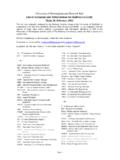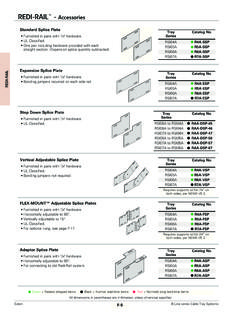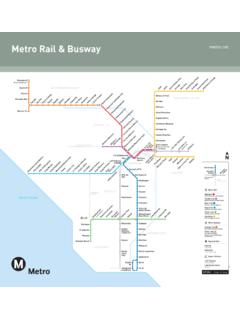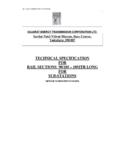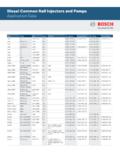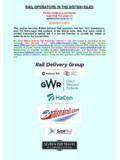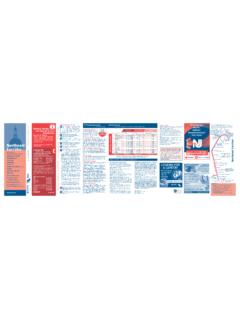Transcription of 'Use of Rail-to-Rail Operational Amplifiers'
1 Application ReportSLOA039A - December 19991 Application of Rail-to-Rail Operational AmplifiersAndreas HahnMixed Signal ProductsABSTRACTThis application report assists design engineers to understand the functionality and benefitsof Rail-to-Rail Operational amplifiers. It shows simplified schematics, functions, andcharacteristics of the output and input stages. Typical application schematics for rail -to-railoperational amplifier are also .. Dynamic Range and SNR in Low Single Supply Systems2.. The Output Stage3.. Construction of a Rail-to-Rail Output Stage3.. The Dependence of Output Signal Load5.. Slew Rate7.. Summary of Output Stage7.. The Input Stage7.. Construction of a Standard Input Stage8.. Construction of a Rail-to-Rail Input Stage9.. Summary of the Input Stage11.. Circuits Which Use the Rail-to-Rail Characteristics12.
2 Unity Gain Amplifier12.. Measurement of the Supply Current12.. Differential amplifier With Rail-to-Rail Output13.. 5-VPP Square Wave Oscillator Up to 600 kHz13.. Digital-to-Analog Converter With a Rail-to-Rail Output as an Adjustable Reference Voltage Source14.. Summary14.. References15.. List of Figures1 Rail-to-Rail Output Stage3.. 2 Output Stage of a TLC227x3.. 3 Output Drive Capability4.. 4 AVD Dependent on the Load for TLV246x5.. 5 Output Signal TLV2462 With 100- Load to Ground6.. 6 Output Signal TLV2462 With 100- Load to VDD/26.. 7 Inverting Amplifier7.. 8 Change From Noninverting amplifier to Buffer8.. 9 Differential Amplifier9.. SLOA039A2 Application of Rail-to-Rail Operational Amplifiers10 Rail-to-Rail Input Stage9.. 11 Input Bias Current10.. 12 Input Offset Voltage10.. 13 Minimizing the Transient Distortions (THD)11.
3 14 Unity Gain Amplifier12.. 15 Current to Voltage Converter12.. 16 Instrument amplifier With Two Operational Amplifiers13.. 17 100-kHz Square Wave Oscillator With 5 VPP13.. 18 5-V Digital-to-Analog Converter With 0 to 5-V Output14.. IntroductionElectrical applications increasingly use a single supply voltage of 5 V or less as portableelectrical equipment becomes more popular. The supply voltage for portable systems can be aslow as the voltage provided by one battery cell ( V). Reduced supply voltage designs mustuse the complete power supply span to have a usable dynamic range. Operational amplifiersthat use the complete span between negative and positive supply voltage for signal conditioningare generally known as Rail-to-Rail amplifiers. The usable span is an important value because itinfluences several parameters such as noise susceptibility, signal-to-noise ratio (SNR), anddynamic range.
4 Signal sources are often connected to the positive or negative supply amplifiers need Rail-to-Rail input capability to match both signal sources with onedevice. This report explains the function and the use of Rail-to-Rail Operational Range and SNR in Low Single Supply SystemsReducing the operating supply voltage from a 15-V split supply to a single 5-V supplysignificantly reduces the maximum available dynamic range. The dynamic range at the output isdetermined by the ratio of the largest output voltage to the smallest output voltage. An industrystandard Operational amplifier like the TLC271 is specified at 5-V single supply with Vpp forthe maximum output swing. This means that the whole supply span can not be used for theoutput swing, resulting in a further reduction of the maximum available dynamic range and Rail-to-Rail Operational amplifier like the TLV24xx family can use the full span of the supplyrange for signal conditioning at the input and amplifier disturbance levels are independent of the supply voltage.
5 This results insmaller spacing between usable and noise signals. If the Operational amplifier is used with acsignals, by decoupling the signals from dc, then noise forms the determining disturbance a standard Operational amplifier such as the TLC271C, the input noise voltage Vn at a signalbandwidth of 1 MHz equals 68 V = 68 nV/ Hz 1 MHz. With a 5-V single supply, the reducedoutput range allows a maximum signal level of Vpp. This results in a unity gain configurationin a SNR of dB=20 log(4 V/68 V). In the same configuration, a Rail-to-Rail amplifier such asthe TLV246xI with Vn=11 nV/ Hz and a maximum signal level of 5 Vpp at the input and outputprovides a signal-to-noise ratio of 113 dB=20 log(5 V/11 V) at BW=1 a precision system the Operational amplifier must amplify the dc voltage level precisely. Errorsin this area result from offset and gain problems.
6 In a 5-V system with a constant common-modevoltage, the TLC271C has an input offset voltage VIO of mV . This alone limits the dynamicrange to 71 dB=20 log(3800 ) in a unity gain configuration. The TLV245x, however, withVIO = 20 V and the Rail-to-Rail characteristic has a significantly higher dynamic range of108 dB=20 log(5000 ) in the same circuitry. Typical values at 5 V single supply and 25 Application of Rail-to-Rail Operational AmplifiersWhen signal-to-noise ratio and dynamic range are critical design parameters, rail -to-railcharacteristics of the Operational amplifier must ensure that these parameters are Output StageIf the output swing from a standard Operational amplifier is not large enough to fit the systemrequirement (for example the analog-to-digital-converter input range), then a rail -to-railoperational amplifier must be used.
7 Operational amplifiers with Rail-to-Rail output stages achievethe maximum output signal swing in systems with low single-supply voltages. They can generatean output signal up to the supply rails. A large output voltage swing results in increased dynamicrange. For example, Figure 1 shows the output signal of a TLV2462 with a 5-Vpp input TLV2462 with a 5-V single supply operates as a voltage follower and drives a load of 1 k .The low 1-k load results in a voltage drop of several mV, which is not visible in the V/DivInput 5 VppOutput 5 VppRL = 1 k VDD = 5 VGroundVDD +5 VINOUTRLF igure 1. Rail-to-Rail Output StageConstruction of a Rail-to-Rail Output StageVDD+GroundVDSVDS +OutputInputstageGGSSDDF igure 2. Output Stage of a TLC227xSLOA039A4 Application of Rail-to-Rail Operational AmplifiersThe Rail-to-Rail characteristic is achieved by altering the output stage construction.
8 Figure 2shows the basic construction of a Rail-to-Rail CMOS output stage as used in the TLC227x. Acomplimentary MOS transistor pair, consisting of a self-locking P-channel and self-lockingN-channel, forms the output. Both transistors operate as a common source circuit. A commonsource circuit functions like a common emitter circuit for bipolar transistors. Along with thecurrent amplification, a voltage amplification also takes place. The voltage loss VDS at the outputstage transistors has a disadvantageous effect on the voltage gain. As the current increasesthrough a MOS transistor the resistance between drain and source increases slightly. Duringhigh loading of the output, this resistance, together with the increased current, results in a highervoltage drop VDS. The full output range of a Rail-to-Rail Operational amplifier is therefore onlyuseable with low load.
9 Figure 3 shows this on the output level of the TLV243x and = 600 5 TLV2432 TLV246x0RL = 50 432104080120160200[IO] High Level Output Current mAVOH High-Level Output Voltage VFigure 3. Output Drive CapabilityReduction of the output signal due to the load also results in a reduction of the open-loop gainAVD. Because the open-loop gain is dependent on the connected load, the load should alwaysbe considered during comparison of the open-loop gain of different amplifiers. Figure 4 showsthe influence of a resistive load on the amplification of a Application of Rail-to-Rail Operational AmplifiersRL Load Resistance 1208040014010060201k10k1M180100100k160TA = 25 C Differential Voltage Amplification V/mVAVDVDD = VVDD = VTLV246xFigure 4. AVD Dependent on the Load for TLV246xThe Dependence of Output Signal LoadIt is important to know which potential the load is connected to when talking about the behaviourof the output signal due to the load.
10 In applications with a single supply, it is typical for the loadto be connected to ground (0V). The requirement from a Rail-to-Rail output is the capability tosupply a load with current. Figure 5 shows an example of this on a TLV2462. The TLV2462functions as a unity gain amplifier and drives a 100- load against the supply ground. Becauseof the 600-mV voltage drop across the output transistor caused by the current, the output canonly drive the signal up to a maximum voltage level of V. The minimum voltage levelhowever, reaches the 0 V of the ground level. At an output voltage of 0 V, no current flowsthrough the load, since both ends of the load are at the same potential. With no current, there isno voltage drop across the output transistor. With a load driven against ground, an output signallimitation due to the load current only occurs at high voltage of Rail-to-Rail Operational AmplifiersVDD = 5 VGround1 V/DivInput 5 VppOutput VppRL = 100 to Ground U = 600 mVVDD +5 VOUTRLINF igure 5.










